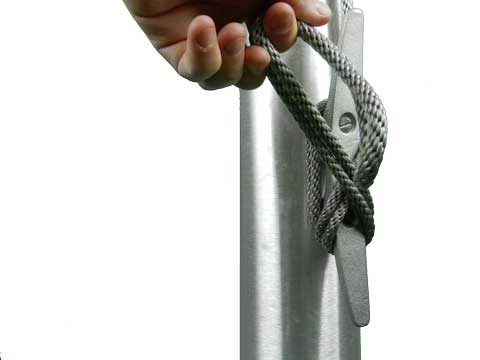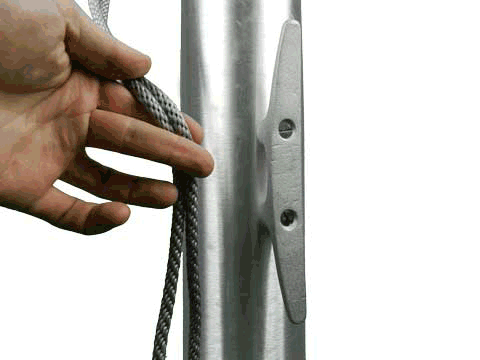Mastering the Art of Flag Hook Rope Attachment
So, you've got a beautiful flag and a sturdy rope, but they're two separate entities longing for connection. Fear not, flag enthusiasts! This guide will equip you with the knowledge to confidently attach your flag hooks to rope, ensuring your stars and stripes (or any other banner) fly proudly and securely. Whether you're a seasoned flag-flyer or a newbie, mastering this skill is essential for proper flag display.
Connecting a flag to a rope might seem straightforward, but a poorly tied hook can lead to tangles, damage, and even premature flag wear. Choosing the right knot and understanding the principles of secure attachment is crucial. This guide will delve into the intricacies of attaching flag hooks, providing you with the tools you need for a successful and visually appealing display.
While the exact origins of using hooks for flag attachment are difficult to pinpoint, the practice likely evolved alongside the use of flags themselves. Historically, flags served as important symbols of identification, communication, and national pride. Ensuring these symbols remained securely displayed, even in challenging conditions, became paramount. Hooks offered a durable and practical solution, facilitating easy hoisting and lowering of flags.
The importance of correctly attaching flag hooks to rope goes beyond mere aesthetics. A secure attachment prevents your flag from becoming tangled, which can lead to damage. It also ensures the flag hangs correctly, allowing it to fly freely and present itself with dignity. Improperly tied hooks can result in the flag wrapping around the rope, hindering its visual impact and potentially causing wear and tear.
There are several issues that can arise from incorrect flag hook attachment. These include slippage, which can cause the flag to droop or fall; fraying of the rope due to friction from a poorly secured hook; and damage to the flag itself from twisting and turning. Learning the proper techniques prevents these problems and extends the lifespan of both your flag and rope.
One of the most common methods for attaching a flag hook to rope involves using a clove hitch. This versatile knot is easy to tie and provides a secure grip on the rope. To tie a clove hitch, make a loop with the rope, place it over the hook, and then make another loop over the first, tightening it snugly against the hook.
Another useful knot is the figure-eight loop. This knot creates a secure loop at the end of the rope, which can then be attached to the hook. To tie a figure-eight loop, make a loop, pass the end of the rope over itself, and then tuck it back through the original loop. This creates a strong and reliable connection point.
Benefits of Correct Flag Hook Attachment:
1. Prevents Flag Damage: A secure connection minimizes flapping and twisting, reducing wear and tear on the flag fabric.
2. Ensures Proper Display: The flag hangs correctly, showcasing its full glory and symbolism.
3. Easy Hoisting and Lowering: A properly tied knot allows for smooth and efficient flag raising and lowering.
Action Plan for Attaching Flag Hooks:
1. Inspect the hook and rope for any damage.
2. Choose the appropriate knot (e.g., clove hitch, figure-eight loop).
3. Tie the knot securely, ensuring it snugs against the hook.
4. Test the connection by gently tugging on the flag.Challenges and Solutions:
1. Slipping Hook: Solution: Use a tighter knot or a different knot altogether, like a double clove hitch.
2. Fraying Rope: Solution: Inspect the rope for damage and replace if necessary. Use a proper knot to minimize friction.
3. Difficult to Untie: Solution: Practice tying and untying the knot. Avoid over-tightening.
4. Hook Breaking: Solution: Use a high-quality, durable hook designed for flagpoles.
5. Rope Too Thick: Solution: Choose a knot suitable for thicker ropes or consider using a larger hook.
FAQ:
1. What type of rope is best for flags? A: Durable, weather-resistant rope like nylon or polyester is recommended.
2. How often should I check my flag hook attachment? A: Regularly inspect the knot and hook, especially after harsh weather.
3. Can I use any type of knot? A: While various knots work, some are more secure and suitable for flagpoles.
4. What if my rope is too thin? A: Consider using a smaller hook or adding padding to the hook.
5. How do I prevent my flag from tangling? A: Ensure the hook is securely attached and the flag is hoisted properly.
6. What if my hook is rusty? A: Replace it with a new, non-rusty hook.
7. Where can I buy flag hooks? A: Hardware stores, flag retailers, and online marketplaces.
8. How tight should the knot be? A: Securely tight, but not so tight that it's difficult to untie.
Tips and Tricks: Practice tying the chosen knot beforehand. Wetting the rope can make it easier to tie. Inspect the rope and hook regularly for signs of wear. Choose a hook size appropriate for the rope and flag size.
In conclusion, correctly tying flag hooks to rope is an essential skill for any flag enthusiast. By mastering the techniques outlined in this guide, you can ensure your flags are displayed proudly and securely, while minimizing the risk of damage. The proper attachment allows your flags to fly freely and gracefully, symbolizing the values they represent. Take the time to learn these techniques and enjoy the satisfaction of a perfectly displayed flag, a testament to your respect for the emblem and the craft of proper flag care. So, gather your flags, ropes, and hooks, and put your newfound knowledge into practice! Fly your colors with pride!
Athens alabama power outages staying connected when the lights go out
Boat air conditioners staying cool on the open water
Unlock serenity with sherwin williams studio blue green














